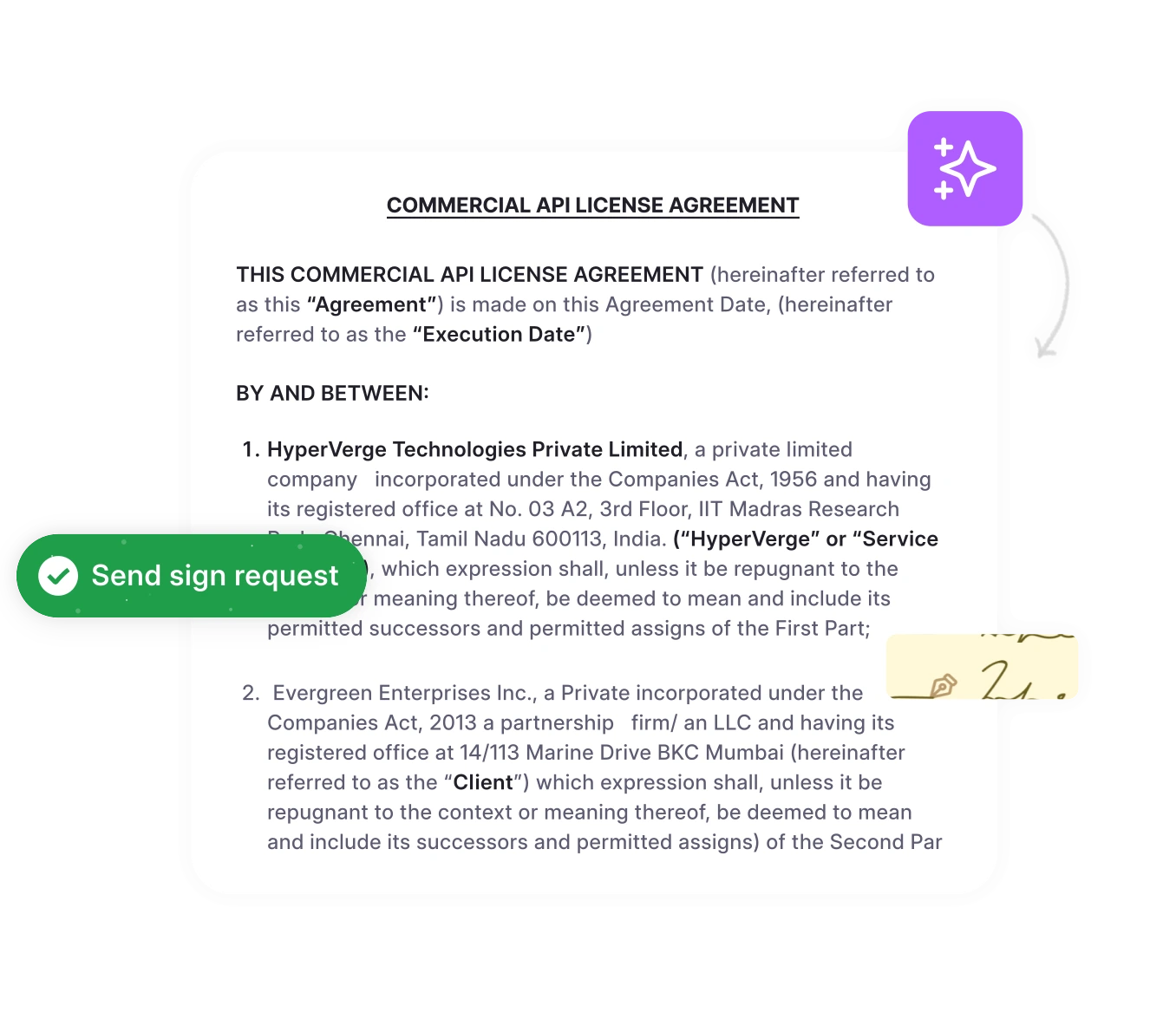If you are a business owner dealing with numerous contracts and agreements you must know the struggle of juggling paperwork to find what you need when you need it. Meeting deadlines updating renewals and legal compliance add to the trouble.
This is where CLM – Contract Lifecycle Management comes into action. It streamlines every stage from negotiation to execution and renewal to termination.
In this blog we will understand CLM meaning, its stages, and its benefits to your business.
What is contract lifecycle management (CLM)?
CLM stands for contract lifecycle management (CLM), which manages all contracts on a single platform from their creation through execution, performance, and eventual renewal or expiration. It also helps businesses meet essential contract lifecycle management requirements, ensuring efficiency and compliance at every stage. It is a structured approach to managing contracts efficiently and effectively throughout their life cycle.
McDonald’s implemented a CLM solution to streamline its contract processes and meet strategic goals.
This allowed them to manage contracts globally on a single platform enhancing collaboration and transparency. Automated contract generation review and approval helped them reduce errors and administrative burdens.
The results:
- 20% cost savings
- 50% faster contract TAT
Now that you’ve got a brief overview of what CLM is and its definition, it’s important to understand the challenges of traditional contract management. For those familiar with contract management, exploring how CLM can overcome these challenges is key. Let’s break it down.
What are the challenges with traditional contract management methods?
Here are the top 5 challenges with traditional contract management:
- This traditional approach not only increased the risk of missed deadlines and compliance issues but also highlighted the need to eliminate paper and adopt more streamlined, digital solutions.
- Manual contract management processes involved drafting contracts from scratch, which required significant paperwork.
- Reviewing contracts involved multiple back-and-forth exchanges via email or physical documents, resulting in several difficult-to-track versions.
- Physical signatures and coordination across locations added significant delays to contract approvals.
- Contracts were stored in physical files or basic digital systems, making document retrieval inefficient and time-consuming.
These issues are just a few of the most common contract management challenges that organizations face. In contrast by using contract lifecycle management software for digital contract management, you can automate tasks and significantly improve the efficiency of your contract management processes.
Now that we understand CLM let’s explore its various stages.
What are the stages of the cloud-based CLM process?
Contract lifecycle management (CLM) involves managing the entire journey of a contract or agreement from initiation to completion. Effective agreement management ensures that every stage is handled thoroughly, with compliance and mutual benefit for all parties. Let’s break down the typical stages of CLM:
1. Contract creation
A legal document reflects both parties’ agreed-upon demands and conditions in the contract creation stage. You should use standardized templates and pre-approved clauses to ensure your contract adheres to legal and organizational standards. This contract creation stage involves detailed contract drafting specifying each party’s terms conditions and obligations. A clear detailed document sets the stage for effective negotiations and a legally sound contract.
2. Contract negotiation
Once you get the draft ready the negotiation stage begins. A survey conducted on the IT sector by the World Commerce and Contract—a US-based research institution—revealed that 73% of organizations believe contract negotiation is an important responsibility for their operations.
In this stage the contract is typically shared via email or a link so the counterparty can collaborate in the browser. Both parties review the contract discuss the terms and make necessary adjustments to reach a mutual agreement. This stage is crucial as it allows both parties to address concerns clarify expectations and find common ground.
It might involve multiple rounds of discussions and revisions to refine the details and align the interests of both parties.
3. Contract approval
After negotiations the contract moves to the approval stage. Here it is reviewed by decision-makers including departmental heads legal teams and executive management to ensure it meets all internal and external requirements. Getting approvals is important as it confirms that all aspects of the contract are in order before proceeding to execution.
Since this is a crucial stage ensuring faster turnaround times and accelerated internal approvals is important. A contract management software like HyperStart can facilitate the contract approval workflow process ensuring seamless contract management.
4. Contract execution
Once you secure approvals the contract is ready for execution. It involves getting the signatures done by all the parties making it legally binding. Traditionally this meant physical signatures but now electronic signatures are commonly used to make the contracting process faster and smoother. With a CLM solution like HyperStart you can secure contract signatures with just 2 clicks. The platform ensures end-to-end encryption for security and operates seamlessly without unnecessary complications.
5. Contract amendment and compliance
Over time contracts need amendments due to changed circumstances or new regulations. So this stage allows you to update the contract to reflect these changes while ensuring it remains compliant with current laws and policies.
The amendment and compliance stage requires careful review and modification of the contract terms followed by approval from all parties. Regular reviews and updates help maintain the contract’s relevance and legal standing throughout its lifecycle.
6. Contract renewal or termination
As the contract expires you must decide whether to renew or terminate it. The contract renewal process involves evaluating the contract’s performance renegotiating terms if necessary and executing a new agreement. If the contract is no longer needed it moves toward termination including proper closure ensuring all obligations are fulfilled and resolving any outstanding payments or issues.
Struggling to keep track of contract deadlines?
Discover HyperStart’s automated alerts and never miss a renewal again.
What are the key features of contract lifecycle management (CLM) software?
Contract management software is a tool that helps you streamline your contract process making it more efficient and less prone to errors. Let’s have a look at its features:
| CLM Software Feature | Description |
| Centralized contract repository | A secure and organized digital library where all contracts are stored. A centralized repository allows easy access to any contract without managing multiple files or cabinets. |
| Automated contract creation | It enables the creation of contracts from scratch using templates to save time and ensure compliance with legal and company standards. Compared to manual processes it reduces time and errors. |
| Workflow automation | Automatically routes contracts for approval based on predefined rules sends reminders and notifications and tracks the contract’s progress through its lifecycle. Provides visibility and accountability at each stage. |
| Compliance and risk management | Ensures contracts meet organizational and legal regulatory requirements. Flags non-compliant terms and suggests standard clauses. Analyzes contract terms for potential risks to help mitigate them. |
| Performance tracking and reporting | Offers features to set and monitor milestones deadlines and performance metrics. Automatically tracks compliance with contract terms and generates reports on parties’ performance. |
| Contract renewal and termination management | Provides alerts and reminders for upcoming contract expirations streamlines the renewal process and ensures proper fulfillment of obligations and closure for terminations. Keeps you on top of renewals and terminations. |
What are the key benefits of using CLM software in the contract management process?
Adopting contract lifecycle management can change how you handle contracts in your organization. It brings features that streamline processes reduce risks and enhance overall efficiency. Here are some of them:
1. Centralized repository for all legacy contracts
One of the major advantages of having a CLM system is all your legacy contracts are stored in one place. A contract repository eliminates the back-and-forth of dealing with scattered documents across different systems and departments. With CLM you can quickly access any contract regardless of its status—whether in process executed or expired. This saves you time and ensures all your contracts are on track.
HyperStart with its advanced AI metadata extraction feature imports contracts from various sources like CRM email or Drive in just a single click. It automatically extracts over 30 key terms from each contract eliminating manual data entry needs. Additionally with role-based access you can control who can view or edit each document. Its centralized dashboard makes all contracts accessible allowing you to search for and open any contract anytime.
2. On-time renewals
As contract lifecycle management software automatically sends you alerts and notifications you never miss important renewal deadlines. This proactive approach prevents costly lapses in coverage or service interruptions and gives you ample time to review and negotiate renewal terms. With CLM you can confidently manage renewals without worrying about manually tracking each one.
With HyperStart contract renewal management is incredibly fast and easy. The system sends timely email alerts 30 to 90 days before contract expiration to ensure you get sufficient time to take action. Renewing a contract takes barely 2 seconds simplifying the process. This streamlined approach reduces contract administration time by 80%.
3. Faster turnaround times and contract redlining
A CLM system with real-time collaboration features allows both parties to collaborate on contract negotiations and redlining. It also allows multiple stakeholders to review comment on and edit the contract in real-time speeding up the negotiation process and reducing turnaround time.
HyperStart accelerates your contract negotiation process with its effective redlining and editing tools. With its in-app editor tool you can redline contracts faster. It allows you to comment and suggest changes in the contract staying within the platform.
Looking to reduce contract review time?
Collaborate in real-time and boost your turnaround time by 5X with HyperStart.
4. Quick contract execution
The traditional contract management process involved printing signing scanning and mailing documents which was quite slow. Contract management tools offer electronic signature capabilities that enable you to execute contracts instantly with just a few clicks. This significantly speeds up the process so you can commence the project without unnecessary delays.
You can implement HyperStart in your daily contract management process to do the same. It allows you to obtain e-signatures from both parties even if they are in different countries without the need for physical documents. It is end-to-end encrypted so there is no chance of alteration. HyperStart offers multiple options to sign including hand-drawn OTP or Aadhar verification. Upon adopting HyperStart you can save up to $20 per contract.
5. Better visibility with dashboard and analytics
Analytics and dashboard features give you a holistic view of all your contracts and their live status. You can track key performance indicators monitor contract statuses and identify potential issues. Such in-depth insights help you make informed decisions optimize contract management processes and ensure your contracts deliver the expected value.
HyperStart offers a comprehensive dashboard that centralizes all aspects of contract management from creation and automation to performance tracking. Its user-friendly interface allows you to monitor pre-execution metrics such as initiation reviews and sign-offs. With HyperStart you can reduce the time spent on contracting by 80%.
HyperStart – Making your contract management effortless
Manual contract management can be tiring and demanding but with the right tools it becomes smoother and easier. CLM software transforms numerous manual tasks into one automated process. HyperStart is one such solution that streamlines contract processes and helps you focus on what truly matters: business growth.
With AI-driven capabilities, HyperStart reduces contract closure times and increases the effectiveness of your contract management efforts. Unlike other tools that take 3-6 months to implement, HyperStart becomes fully operational in just 3 days, so you can start benefiting right away.
Try HyperStart for free and experience the convenience of it yourself.












